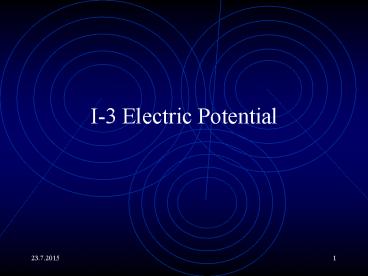I-3 Electric Potential - PowerPoint PPT Presentation
Title:
I-3 Electric Potential
Description:
So we come to the general formula: W=q[ (B)- (A)]=U(B)-U(A)=qVBA ... So the magnitude E is the slope of the potential and the vector points in the ... – PowerPoint PPT presentation
Number of Views:17
Avg rating:3.0/5.0
Title: I-3 Electric Potential
1
I-3 Electric Potential
2
Main Topics
- Conservative Fields.
- The Existence of the Electric Potential.
- Work done on Charge in Electrostatic Field.
- Relations of the Potential and Intensity.
3
Conservative Fields
- There are special fields in the Nature in which
the total work done when moving a particle on
along any closed path is zero. We call them
conservative. - Such fields are for instance
- Gravitational - we move a massive particle
- Electrostatic - we move a charged particle
4
The Existence of the Electric Potential
- From the definition of a conservative field it
can be shown that work done by moving a charged
particle from some point A to some other point B
doesnt depend on the path but only on the
difference of some scalar quality in both points.
This quality is called the electric potential ?.
5
Work Done on Charge in Electrostatic Field by an
External Agent I
- If we (as an external agent) move a charge q from
some point A to some point B then we do work by
definition - W(A-gtB)q?(B)-?(A)
6
Work Done on Charge in Electrostatic Field II
- Since doing positive work means increasing of the
energy, we can define a potential energy U - Uq?
- Then
- W(A-gtB)q?(B)-?(A) U(B)-U(A)
7
Work Done on Charge in Electrostatic Field III
- In almost all situations we are interested in the
difference of two potentials. We define this
difference as the voltage V - VBA ?(B)-?(A)
- Then
- W(A-gtB)q VBA
8
Work Done on Charge in Electrostatic Field IV
- So we come to the general formula
- Wq?(B)-?(A)U(B)-U(A)qVBA
- Try to understand well the difference
- between the potential, the potential energy and
the voltage! - between the work done by the field and an
external agent!
9
The Impact of the Potential
- Since the potential exists, we can describe fully
the electrostatic field using the scalar
potential field ?(r) instead of the vector
intensity field E(r). - We need only one third of information
- Superposition means just adding numbers
- Some terms converge better
10
Relations Between Potential and Intensity I
- It is convenient to describe this in terms of
potential energy and force so we dont have to
care about the polarity of the charge and use
examples from the gravitation field. - Lets have a charged particle and a force F
acting on it. - If the particle moves by dl the field does work
dWF.dl .
11
Relations ? versus E II
- The sign of this work depends on the projection
of the path vector dl into the force F. - If the field does a positive work it must be at
the cost of lowering the potential energy of the
particle i.e. dWgt0 means dUlt0. - So dW F.dl -dU
- To get work for some finite path A-gtB we just
integrate.
12
Uniform ? Homogeneous Field I
- Let us move a unit charge some distance d in the
direction of the intensity E. Since both vectors
are parallel the work is positive and the
integral is a simple multiplication - Ed-?(B)-?(A)gt0
- This means ?(B)?(A)-Ed so along the field lines
the potential ? is decreasing!
13
Uniform Field II
- We can also get E from the potentials
- E-?(B)-?(A)/d?(A)-?(B)/d
- So the magnitude E is the slope of the potential
and the vector points in the direction of
decreasing potential. - Roughly E depends on the change (derivative) of ?
and ? on sum (integral) of E.
14
Uniform Field III
- If we want to know the work done on a non-unity
charge by the field or an external agent, we have
to take into account the charge and deal with the
potential energy. Bigger charge sees bigger
slope in potential energy and negative charge
sees an opposite slope! - Roughly E depends on the change (derivative) of
? and ? depends on sum (integral) of E.
15
The Units
- The unit of ? or V is 1 Volt.
- ? U/q gt V J/C
- E ?/d V/m
- ? kq/r V gt k Vm/C gt
- ?0CV-1m-1
16
Homework 2
- The homework is selected for problem sections
that are in the end of each chapter. - 21 17, 19
- 22 1, 2, 4, 6, 12, 26
- 23 7, 10
- You are free to try to answer to the questions in
the questions sections!
17
Things to read
- Chapter 23-1, 23-2
18
Work Done by the Field A-gtB
- Now we can divide it by the test charge q
- This is generally ho to get ? from E.































